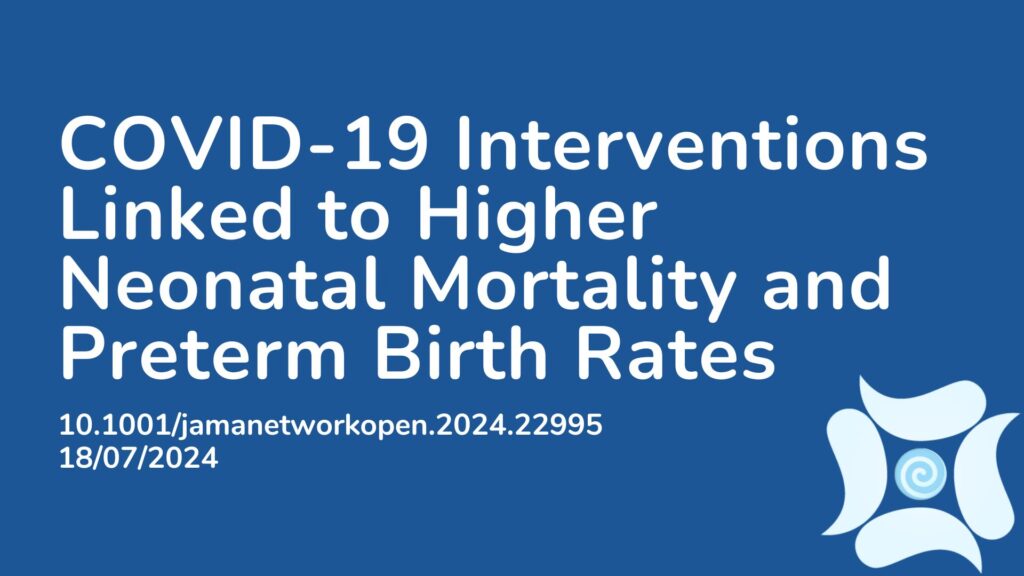Summary:
The COVID-19 pandemic significantly impacted global health care systems and was declared a public health emergency by the World Health Organization on January 30, 2020. The virus prompted interventions such as lockdowns, school and workplace closures, and travel restrictions. Social distancing and other measures effectively reduced COVID-19 spread but also led to reduced health care access and increased morbidity and mortality. Pregnant individuals faced significant health care access challenges, contributing to higher maternal and fetal mortality and pregnancy-related complications, potentially affecting neonatal and infant outcomes as well. Population-based studies on perinatal, neonatal, and infant outcomes during the pandemic have shown varied results. There is a lack of national studies correlating social distancing with infant outcomes. Therefore, this study assessed whether social distancing during the pandemic was associated with higher neonatal mortality rates. The study included over 18 million births and showed no significant difference in mortality rates during the pandemic period compared to expected rates of mortality. However, further analyses found that social distancing measures were associated with higher rates of neonatal and early neonatal mortality (deaths within the first 7 days of life) and preterm birth rates, highlighting the need to monitor infant health outcomes following pandemic-related behavior changes and the importance of connection, support, and interaction for pregnant mothers.
Abstract:
Importance: Neonatal mortality is a major public health concern that was potentially impacted by the COVID-19 pandemic. To prepare for future health crises, it is important to investigate whether COVID-19 pandemic–related interventions were associated with changes in neonatal mortality. Objective: To investigate whether social distancing during the pandemic was associated with a higher neonatal mortality rate. Design, Setting, and Participants: This cohort study examined maternal-linked birth and infant death records from the National Center for Health Statistics, a population-level US database, from 2016 through 2020. The mortality rates were correlated using machine learning–based autoregressive integrated moving average (ARIMA) models with the social distancing index (SDI). The reference period was January 2016 through February 2020, and the pandemic period was March through December 2020. Statistical analysis was performed from March 2023 to May 2024. Exposures: SDI, computed from 6 mobility metrics. Main Outcomes and Measures: The primary outcome was neonatal mortality rate, defined as death at age less than 28 days. Results: The study included 18 011 173 births, of which 15 136 596 were from the reference period (7 753 555 [51.22%] male; 11 643 094 [76.92%] with maternal age of 20 to 34 years) and 2 874 577 were from the pandemic period (1 472 539 [51.23%] male; 2 190 158 [76.19%] with maternal age of 20 to 34 years). Through ARIMA-adjusted analyses, accounting for the declining mortality trend in the reference period, the mortality rates during the pandemic period did not significantly differ from the expected rates. SDI did not exhibit significant correlations with neonatal mortality (unadjusted: correlation coefficient [CC], 0.14 [95% CI, −0.53 to 0.70]; ARIMA adjusted: CC, 0.29 [95% CI, −0.41 to 0.77]), early neonatal mortality (unadjusted: CC, 0.33 [95% CI, −0.37 to 0.79]; ARIMA adjusted: CC, 0.45 [95% CI, −0.24 to 0.84]), and infant mortality (unadjusted: CC, −0.09 [95% CI, −0.68 to 0.57]; ARIMA adjusted: CC, 0.35 [95% CI, −0.35 to 0.80]). However, lag analyses found that SDI was associated with higher neonatal and early neonatal mortality rates with a 2-month lag period, but not with infant mortality rate. SDI was also associated with increases in 22-to-27 weeks’ and 28-to-32 weeks’ preterm delivery with a 1-month lag period. Conclusions and Relevance: In this population-level study of National Center for Health Statistics databases, neonatal, early neonatal, and infant mortality rates did not increase during the initial COVID-19 pandemic period. However, associations were observed between the pandemic period social distancing measures and higher rates of neonatal and early neonatal mortality, as well as preterm birth rate with a lag period, suggesting the importance of monitoring infant health outcomes following pandemic-related population behavior changes.
Article Publication Date: 18/07/2024
DOI: 10.1001/jamanetworkopen.2024.22995



